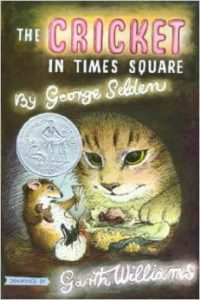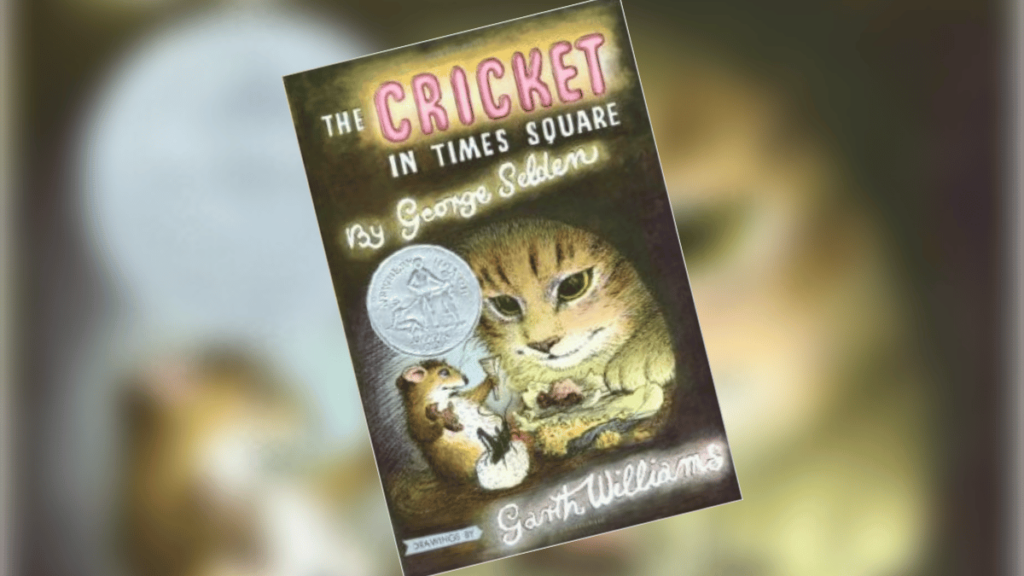Book Review of The Cricket in Times Square
The Children’s Book Review
 The Cricket in Times Square
The Cricket in Times Square
Written by George Selden
Illustrated by Garth Williams
Age Range: 7-10
Paperback: 151 pages
Publisher: Farrar, Straus and Giroux (1960)
ISBN-13: 978-0312380038
What to expect: Animals, Insects, Crickets, Mice, Cats, New York, Friendship, Adventure, Saying Goodbye, Loss
The Cricket in Times Square may be the perfect book for Charlotte’s Web devotees. Cricket has many of the same, masterful literary components as Charlotte’s Web: A homesick animal who must adjust to a new environment? Check. A cast of animal characters who supports the confused, lost friend? Check. A young child who befriends and defends the seemingly helpless animal? Check.
Cricket tells the story of Chester, a cricket who, after accidentally trapping himself in a picnic basket in his home state of Connecticut, finds himself in the Times Square subway station. Once he frees himself from the basket, Chester is alone, afraid, and quickly becoming hopeless. After several days alone in his cold pile of dirt in the corner of the subway station, Chester begins to chirp, a sweet plea for help. His chirps, so unique in the din of the city, are heard by Mario, a poor boy, the son of Italian immigrants who run a newsstand in the station.
Mario is immediately enchanted with the cricket. He gives Chester shelter in the form of a matchbox in the newsstand, despite the rather forceful objections of his mother. A local cat and mouse (who are an unlikely but somehow totally believable pair) befriend Chester; the quirky trio meet in the evenings after the newsstand closes to talk and listen to Chester’s musical chirps. As the story progresses, we discover that Chester’s musical ability far surpasses that of any ordinary cricket. It is this phenomenal talent that eventually brings Mario’s struggling family some much-needed luck and fortune.
Eventually, Chester can no longer deny that he loves the Connecticut countryside far more than the bright lights of New York City. In the most emotional moment of the book, Chester gives Mario a private concert, a musical, emotional goodbye. (Have tissues at the ready, especially if you’re reading aloud to your child. I cried without reservation when I read this scene to my daughter last summer.) When Chester leaves the city (via subway, of course), he leaves behind a cat, a mouse, and a human family, all of whom are saddened by his departure but contented for having known him at all.
As in Charlotte’s Web, Garth Williams’ illustrations in Cricket make this sweet story even more endearing. As in Charlotte’s Web, Cricket teaches us that goodbyes, though painful, are part of life. As in Charlotte’s Web, Cricket shows us that even the smallest individual can make a major difference in many lives.
Is Cricket a better book than Charlotte’s Web? No, but it’s also not a worse book. It is (despite all above evidence to the contrary) a different book. While Cricket and Charlotte’s Web do share similar themes and lessons, Cricket also provides some elements not found in Charlotte’s Web.
The setting in Cricket is a breath of fresh, albeit big-city, air. Farm stories are charming, but it is oddly refreshing to read about a place with some grit and some toughness. By the time I was eight years-old, I had read countless tales that took place in a country setting, but only a handful that occurred in a city. Cricket served as an introduction to the world beyond my suburban neighborhood. It made me realize that there was an amazing place – sometimes intimidating, sometimes fascinating, always interesting – outside my experience.
Cricket also introduces children to the American story. We meet Mario’s parents – hard-working, Italian immigrants who want to give their son a better childhood than they had. We get to explore Chinatown when Mario decides to buy Chester a pagoda-style cage.
When I read Cricket to my daughter earlier this year, she was truly intrigued by the idea of Chinatown and Little Italy. Cricket served as a launch point for a long conversation with my inquisitive little girl, a conversation about American history, about immigrants, about my grandparents’ trip to the United States from Poland and Czechoslovakia. This teaching aspect of Cricket is worth the price of a whole stack of Charlotte’s Webs. (I know, I know…heresy!)
In Charlotte’s Web, the human child (Fern) never has to say a final goodbye to any animal or arachnid friend. Cricket’s Mario realizes Chester has left the newsstand and he is forced to deal with his sadness.
“He won’t come back,” said Mario.
“How do you know?” said Papa.
“The bell’s gone,” said Mario. “You and I and the cricket were the only ones who knew where it was…My cricket took it and went home.” Mario’s voice dropped off abruptly. But then it came back firm. “And I’m glad.”
Showing a young reader that another young person can say goodbye, can show empathy, and can accept the loss? Priceless.
I rediscovered The Cricket in Times Square last summer with my daughter. We now have the delightful voices of Chester and Mario in our heads. They whisper to me along with Fern and Charlotte, each of them offering a different – but equally lovely – perspective.
Add this book to your collection: Charlotte’s Web
Available Here:
About George Selden
George Selden (1929-1989) was the author of The Cricket in Times Square, winner of the 1961 Newbery Honor and a timeless children’s classic. Born in Hartford, Connecticut, Selden received his B.A. from Yale, where he was a member of the Elizabethan Club and contributed to the literary magazine. He spent three summer sessions at Columbia University and, after college, studied for a year in Rome on a Fulbright Scholarship.
People often asked Selden how he got the idea for The Cricket in Times Square. “One night I was coming home on the subway, and I did hear a cricket chirp in the Times Square subway station. The story formed in my mind within minutes. An author is very thankful for minutes like those, although they happen all too infrequently.” The popular Cricket series grew to seven titles, including Tucker’s Countryside and The Old Meadow
In 1973, The Cricket in Times Square was made into an animated film. Selden wrote more than fifteen books, as well as two plays. His storytelling blends the marvelous with the commonplace realities of life, and it was essential to him that his animal characters display true emotions and feelings.
Selden lived in New York City until his death in December 1989. He enjoyed music, archaeology, and J.R.R. Tolkien. His editor, Stephen Roxburgh, said, “Chester Cricket, Harry Cat, Tucker Mouse, and their friends celebrate the triumph of innocence and camaraderie over cynicism and selfishness. George Selden is gone, but his voice lives on in Chester Cricket’s song.”
About Garth Williams
Garth Williams (1912-1996) illustrated all seven of the Chester Cricket books and many other distinguished works, including Stuart Little, Charlotte’s Web, and the Little House series by Laura Ingalls Wilder.
The Cricket in Times Square, written by George Selden and illustrated by Garth Williams, was reviewed by Kelley Smith. Discover more books like The Cricket in Times Square by following along with our reviews and articles tagged with Adventure, Books Set in New York, Classics, Friendship, Garth Williams, Insects, and Loss.

